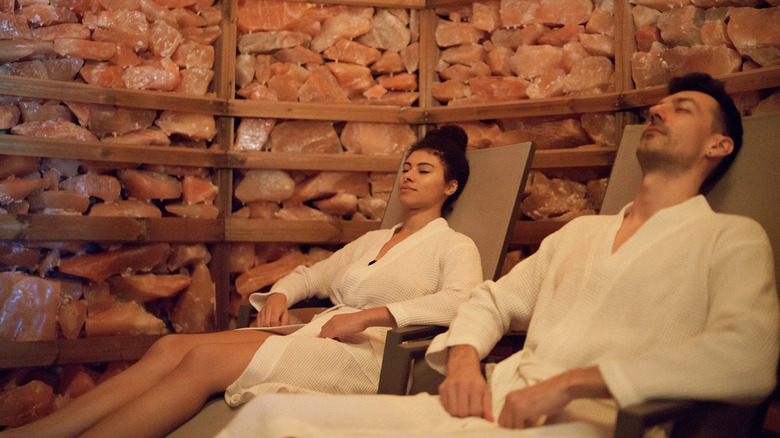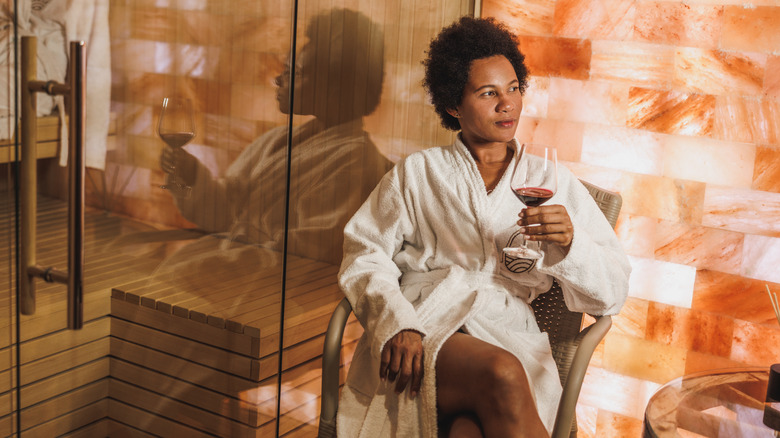What To Know About Salt Room Therapy & Its Potential Benefits
As our culture dives deeper and deeper into personal wellness journeys, a lot of different types of natural therapies are coming into the fold. It seems that, despite there being more medicinal aids than ever before, people are reaching back in time and taking a page from ancestral and Indigenous remedies.
Salt therapy, for example, dates as far back as 400 BCE to Ancient Greece, when salt was used as a treatment for respiratory issues by Hippocrates. Less ancient was the discovery in the 19th century that those who worked in salt mines in Poland had fewer skin and breathing issues than those who weren't exposed to salt particles, per Natural Salt Therapy. Then just a decade ago, a 2023 study published in BMC Psychiatry found that exposure to negative ions, like those in salt, can help decrease feelings of depression in those who suffer from depression and anxiety.
The takeaway? While too much table salt may not be doing your blood pressure any favors, inhaling salt particles can offer some pretty exciting benefits.
What salt room therapy looks like
Salt room therapy takes place in what's sometimes called a salt cave in which you're surrounded by salt particles in the air. While sitting in a room with different types of salt can be a good place to embrace mindfulness and ease stress, these spaces aren't considered therapy spaces. "For what would be considered a true halotherapy experience, you need a room with the particle generator," functional medicine specialist Melissa Young, MD told Cleveland Clinic.
While in the room, you essentially just sit there and breathe normally for about 45 minutes to an hour. The particles are microscopic, so you won't feel (or taste!) a difference with each inhale. "The sole purpose of a halogenerator is to mimic what a natural salt mine or cave would be by breathing in tiny micro-sized salt (pharmaceutical-grade sodium chloride) particles that are tiny enough to reach deep inside the lungs," owner of The Salt and Sauna Sanctuary Jennifer Baker-Johnson told Byrdie.
How you choose to use the time in the cave is up to you. Some people like to sit there with their eyes closed and relax, while others choose to meditate. In addition to breathing in the salt, the space and solitude should be considered as a retreat from the usual day-to-day regimen.
What are the potential benefits
Although there are those who sing the praises of salt therapy, not everyone is on board with its benefits. A 2022 study published in Alternative Therapies in Health and Medicine found that those suffering from chronic respiratory disease may experience positive effects because of how the salt decreases mucus. The same research, however, stated there needs to be more studies on the subject. Senior Scientific Advisor to the American Lung Association, Dr. Norman Edelman, believes the benefits are based on a placebo effect, but does agree with the 2022 study's findings that salt particles in the airway linings do "draw water into the airway, thinning the mucus."
On the flip side, there are people who tout the benefits like Salt Therapy Association's Adam Loss. "Evidence and research about halotherapy and the impact it has on people with certain respiratory conditions, has found that the inhaled dry salt particles have [certain properties]... which may benefit in reducing inflammation of the entire respiratory tract and widening the airway passages," Loss told Harper's Bazaar. Loss also said the skin's pH and flora can be balanced in salt therapy, thereby healing fissures and scratches, as well as eliminating dry skin. Salt therapy can also stimulate cell growth, according to Loss.
Whether the benefits are placebo or not, if someone turns to salt therapy and experiences positive effects, that's what matters. No one should rely solely on salt caves for respiratory issues. "View it as an extra to your normal treatments ― not a replacement," functional medicine specialist Melissa Young, MD told Cleveland Clinic. And, of course, talk to your doctor before trying any alternative therapy.


